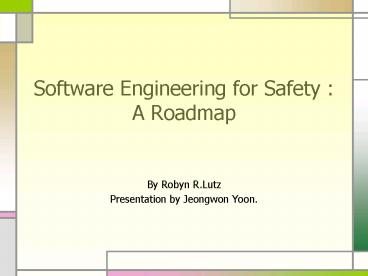Software Engineering for Safety : A Roadmap - PowerPoint PPT Presentation
1 / 18
Title:
Software Engineering for Safety : A Roadmap
Description:
from nuclear & defense applications to medical services, traffic ... confirm that software does what it should - confirm that there aren't unexpected behaviors. ... – PowerPoint PPT presentation
Number of Views:43
Avg rating:3.0/5.0
Title: Software Engineering for Safety : A Roadmap
1
Software Engineering for Safety A Roadmap
- By Robyn R.Lutz
- Presentation by Jeongwon Yoon.
2
Agenda
- Introduction
- Six key areas for safety
- Six directions for future work.
- Conclusion
- Evaluation
3
I. Introduction
- Wider use of safety-critical systems
- - from nuclear defense applications to
medical services, traffic control. - The Nation depends on fragile software
- - needs of software engineering of
safety-critical systems
4
II. Six key areas
- Hazard analysis
- Safety requirements specification analysis
- Designing for safety
- Testing
- Certification and standards
- Resources
5
1. Hazard Analysis
- Core of the development of safe systems.
- Two methods
- - Identify and analyze hazard
- - Investigate which s/w components
contribute or prevent hazard - Derive safety requirements constraints
- on design of system.
- Help prioritize requirements to focus
- vulnerable features.
6
2. Req. specification Analysis.
- Formal specification
- - make development easier more accurate
- - allow formal analysis
- investigate if safety properties are
preserved - ex) model checker, interactive theorem
prover - Translating system safety req.-gtsoftware req.
- - problem mismatches between them.
- - SpecTRM
7
3. Designing for safety
- Design includes
- - prevent hazard ex) hardware lockout,
interlock.. - - detect control hazard ex) fail-safe
design, self-test.. - Three obstacles in design
- - Design tradeoffs
- between safety and other desirable
attributes - - Vulnerability to simple design errors
- - Limited use of known design techniques
8
4. Testing
- Role
- - verify fault-tolerance aspects
- - check whether software responds appropriately
- - test cases focusing on boundary, anomalous
condition - Correct assumptions about
- environment, users, operations.
- Measuring and modeling software reliability
9
5. Certification Standards
- Certification needs criteria for assess
- - more complicated, less well-defined
- Standards
- - issue what standards are appropriate for
large, safety-critical systems composed of
subsystems from different domains? - - Problems lack of guidance, poor
integration - - Recommendation
- Classifying and evaluating standards
- Constructing domain specific standards
10
III. Six direction for future
- Further integration of informal formal methods
- Constraints on safe reuse safe product families
- Testing and evaluation of safety-critical systems
- Runtime monitoring
- Education
- Collaboration with related fields
11
1. Integration of informal formal methods
- Three working area
- Automatic translation of informal notations into
formal models - - integrating graphical tool, visual
programming environment.. - Lightweight formal method
- Integration of previously distinct formal
methods. - - to have flexibility to choose the
best-suited method
12
2. Constraints on safe reuse safe product
families
- Two research area
- Safety analysis of product families
- - need to know extent to which systems with
similar requirements - can reuse requirements analysis
- Safe reuse of COTS software
- - confirm that software does what it should
- - confirm that there arent unexpected behaviors.
13
3. Testing evaluation
- Four challenges
- Requirement-based testing
- - Integration of testing tool with
requirements analysis tool - - improved test-case generation for
safety-related scenarios. - - better support evolutionary development
- Evaluation from multiple sources
- - how to structure combine information
- - include field studies of deployed system
- Model consistency
- - mismatches between actual expected
behavior - Virtual environments
14
4. Runtime Monitoring
- Monitoring
- - Enhance the safety by detecting recovering
from hazardous states. - Role
- - Detection of known faults
- tradeoff between safety and complexity
- - Detection of unexpected faults
- - Monitoring to profile usage
- enhance safety analysis by identifying
evolving hazardous - conditions, deviations from requirements
15
Education Collaboration
- 5. Education
- - For graduate more scientific issues
- - For undergraduate textbook, case-based
learning - 6. Collaboration with related fields
- - Security and survivability
- - Software architecture
- - Theoretical computer science
- - Human factors engineering
- - etc..
16
Conclusion
- SE for safety Demands
- Advances in related fields
- Better integration of safety techniques with
industrial development environments.
17
Evaluation
- Strength
- - Clear explanation
- - Appropriate example to help understanding
- Weakness
- - Too theoretical approach
- - Too many quotation and attempt to cover
several area degrade papers coherence. - Relevant to embedded system
- - safety is essential factor of embedded
systems.
18
Question?































